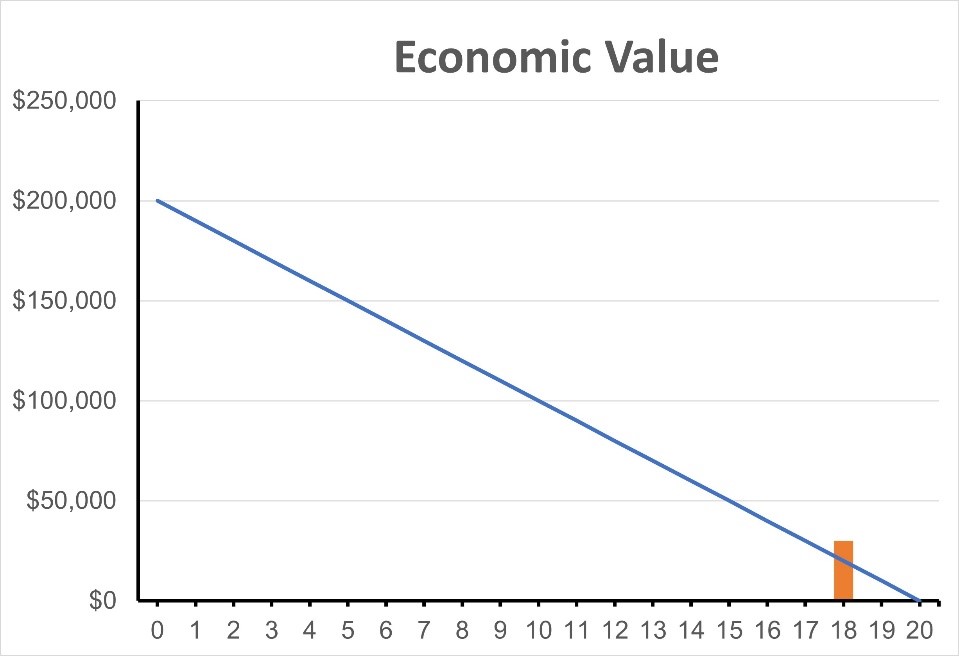Clients often ask, “When is the appropriate time to replace a reserve component?” A few weeks ago, I had the privilege of working with an Association client with this exact dilemma. Our analysis and research about age and material quality led us to conclude that the Association’s shingle roof was due for a full replacement. The Board Member’s response was that they felt the roof could wait another couple years since they had only experienced minor leaks up to this point. Couldn’t they wait and see what happens? After all, it was summer and the Southern California rainy season was over. This was an interesting argument, but in order to fully answer and gain insight into this situation, let’s look at another illustration.
If you are driving your car and notice that the gas tank level is beginning to get low, when should you fill up the car with gas? Should you refill when there is a quarter of the tank left, when the fuel light comes on, or when the car runs out of gas? Although you certainly could choose to push the limits of the gas tank and end up empty on the side of the road, this would not only be impractical and time-consuming, but would increase your costs. Instead of simply filling up the car, now you will have to contend with towing it to a local gas station or getting yourself back and forth to a gas station (after buying a gas can and a gallon of gas). Now think how your decision-making would be different if your niece was in the back seat and you had the responsibility of getting her to school on time. Waiting until “failure” begins to look absolutely foolish.
Now, let’s get back to the situation of the roof. Most roofing vendors will tell you that roof life is pretty stable, depending on material, maintenance, location, and exposure to elements. In other words, you can see failure coming. So if the roof’s life expectancy (confirmed by roofer and Reserve Study provider) is 20 years, and you’re at that point, should you go ahead and replace it, because, after all, the leaks that were fixed were minor? But minor leaks are evidence of upcoming failure. Major leaks damaging the roof structure, and water intrusion into units will follow. Both are expensive! Delaying a scheduled $200,000 roofing project “because you don’t think it needs it”, resulting in the project climbing to $250,000 for roof repairs and interior unit damage repairs is a classic case of being “penny wise and pound foolish.” And that’s not even touching the liability problem the Board incurred in ignoring professional counsel! The owners elected you to care for the common areas, not roll the dice about its maintenance, inconveniencing owners and causing the project to go over budget.
But what if the situation is not so clear? What if your 20-yr life expectancy roof is not at the end of its Useful Life, after minor leaks? What if it is 18 years old, and the leak repair costs are mounting? How do you make the “repair” or “replace” decision? Consider the following example… it’s actually pretty simple. For a $200,000 roof with a 20-yr life, its economic value drops from $200,000 to zero over 20 years. Any year that the repair or maintenance expenses rise above the roof’s economic value, it is better to replace it than continue spending to repair it. See below… if repair costs total $30,000 when the roof itself is only “worth” $20,000 (rising “above the line”), it is time to replace.

This same type of economic analysis works for any major component like fence, roadway, boiler, or cooling tower repairs, etc. The equation is:

As a Board Member (or manager) it is important to make informed decisions, not risky or foolish decisions. The job of the board (and management) is to care for the facilities and funds of the association. Delaying Reserve projects can be expensive and foolish. Don’t “run out of gas” when you can act responsibly, on an informed basis, and take good care of the association and its funds. In the end, it really is a simple decision.

